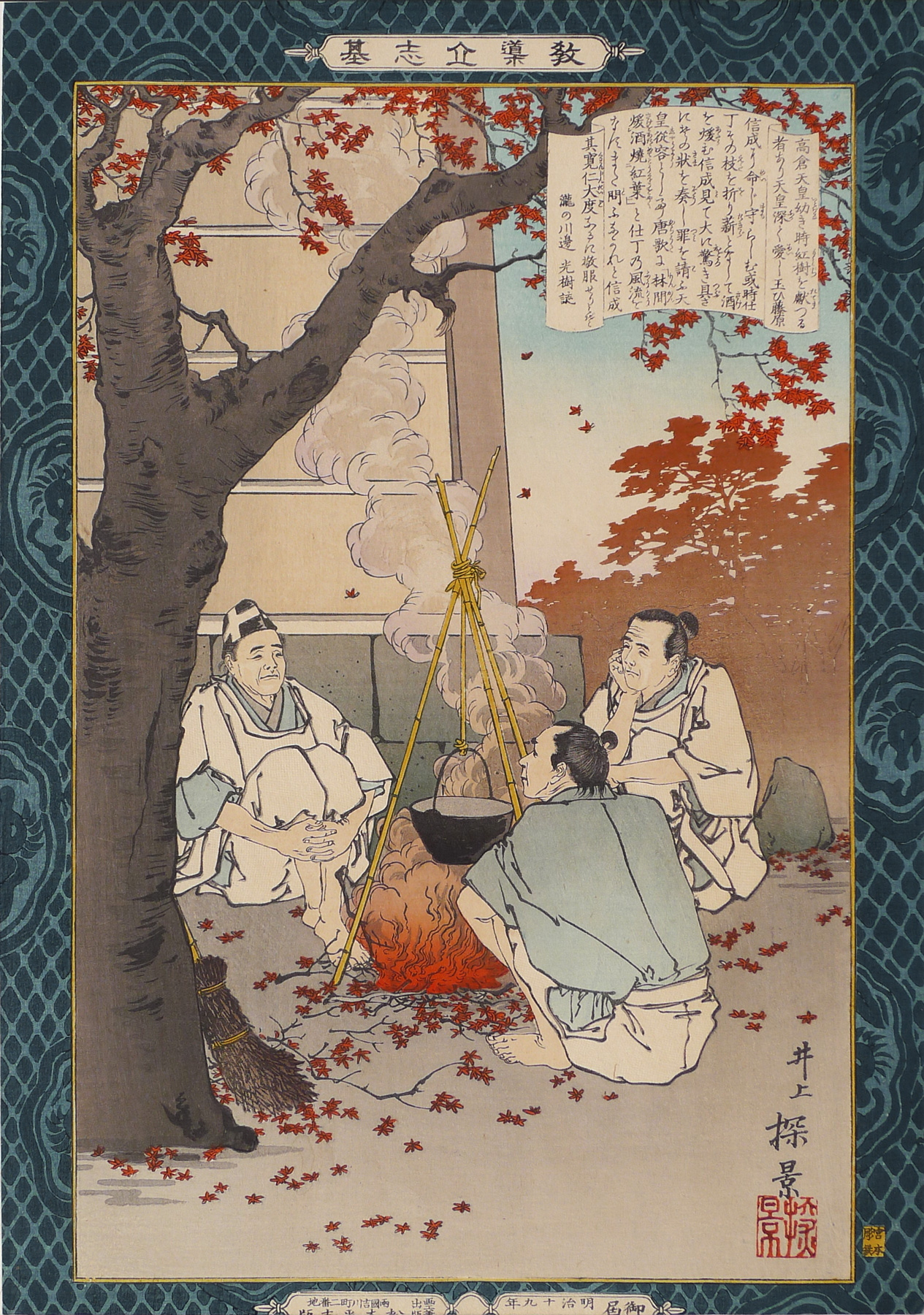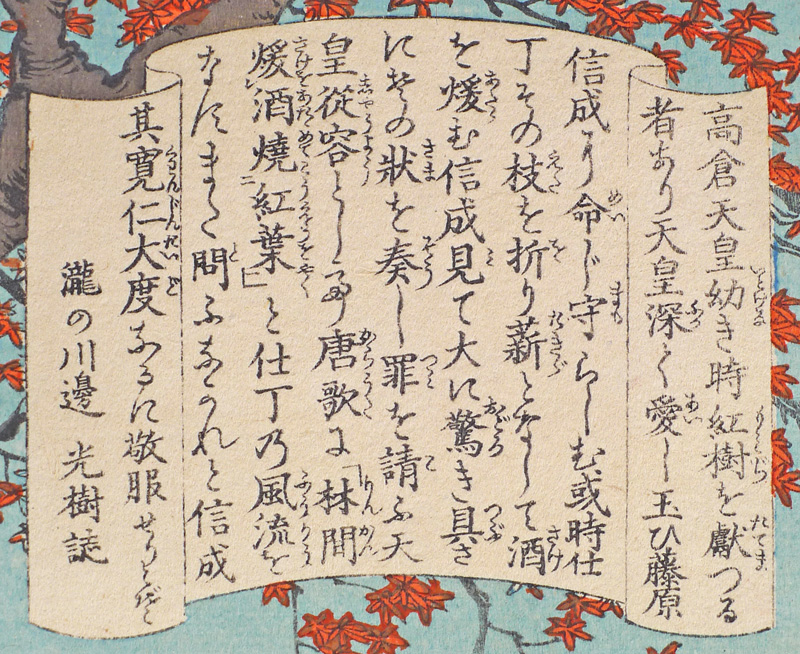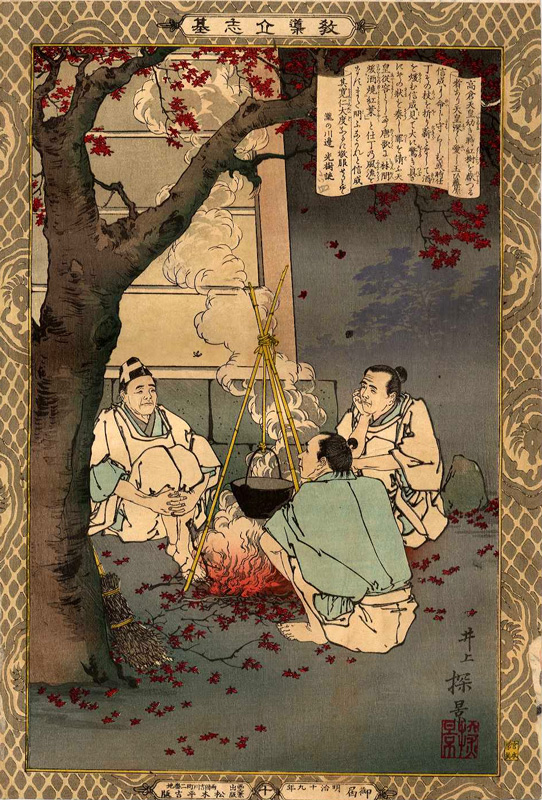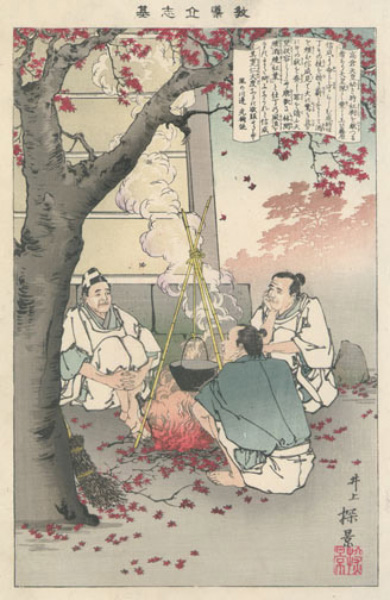About This Print
Print number 10 (十)1 in the series Instructive Models of Lofty Ambition picturing three palace servants of the young Takakura Tennō (高倉天皇 , 1161-1181 CE) warming sake over downed maple branches from the Emperor’s special garden “The Hill of Autumn Tints.”Inoue, a student of Kobayashi Kiyochika, contributed thirteen prints to this series. He was to die at the age of 25 in 1889, three years after this print was issued.
1 Numbering of the prints was haphazard during the production of the series. Print numbers were sometimes inadvertently omitted, as in the case of this print; some prints in the series were never assigned numbers and a few of the same numbers appear on different prints.
Transcription of Scroll
A scroll, present on each print in the series, contains brief historical details of the figure and scene being portrayed.
click on image to enlarge
Source: with thanks to Yajifun http://yajifun.tumblr.com/
10 Takakura Ten’no 高倉帝仕丁
教導立志基 十 高倉帝仕丁 井上探景(安治) 1886年
Transcript:
“高倉天皇幼き時 紅樹(もみぢ)を獻(献)つる者あり 天皇深く愛し玉ひ藤原信成に命じ守らしむ 或時仕丁その枝を折り薪となして酒を煖む 信成見て大に驚き具(つぶ)さにその状(さま)を奏し罪を請ふ 天皇従容として唐歌に「林間煖酒 焼紅葉」と 仕丁乃風流をなす また問ふなかれと 信成其寛仁大度なるを敬服せりとぞ 瀧の川邊光樹 誌”The Story
Source: The Life of Ancient Japan: Selected Contemporary Texts Illustration Social Live and Ideals Before the Era of Seclusion, Kurt Singer, Routledge, 2014, p. 151-152.
AUTUMN LEAVES: A BOY-EMPEROR AND HIS SERVANTS When Takakura Tennō1 was on the Throne everybody declared that his consideration for others surpassed even that of the Mikados of the periods Enki and Tenryaku, and though generally speaking it was after he had attained to years of discrimination that he obtained his reputation for wisdom and benevolence, yet his disposition was kind and gentle from his earliest childhood.
During the period Shoan, when His Majesty was only about ten years old, being extremely fond of the tinted leaves of autumn, he had a little hill-garden made, in the north enclosure of the Palace, and planted it with maple and “haze” trees that redden beautifully in that season, call it “The Hill of Autumn Tints: and from morning till evening he never seemed to tire of looking at it. But one night a late autumn gale blew violently and scattered the leaves everywhere in confusion, so the next morning, when the Palace servants went round early as usual to clean the grounds, they swept up all the fallen leaves and the broken branches as well, and as it was a bleak and cheerless morning they made a fire with them in the court of the Nuidono, and heated some sake to warm themselves.Soon afterwards, the Kurando2 in waiting, hastening to inspect the garden before the Emperor should see it, and finding nothing there, enquired the reason and the servants told him. “What?” he exclaimed, “how could you dare to treat the garden that the Emperor is so fond of in such a way? You deserve to be imprisoned or banished at least, and I too may very likely incur the Imperial displeasure.” Just then the Emperor, coming out to see his favourite trees as soon as he had left this bed-chamber, was surprised to find they had all disappeared, and the Kurando told him what had happened. To his surprise His Majesty was not at all angry, but only laughed and quoted the Chinese poem by Haku-raku-ten (Po-chu-i) about warming wine in the woods by burning maple-leaves. “I wonder” he said, “who can have taught it [to] them. Really they are quite esthetes.”
I kindled a fire of the fallen leaves
To warm my wine.
I cleared the stone of its mossy coat,
And on nature's tablet my verse I wrote.
- the Chinese poet Hakuraku 白楽
1 Son of Emperor Shirakawa II. He came to throne as a boy of 8 years in 1169 and ruled until 1180, one year before his death.
2 High Court official, originally an Archivist.
Variant Printing and Re-issued Print
About The Series "Kyōdō risshi no motoi"
Notes:1. This series is variously translated as "Instructive Models of Lofty Ambition," "Foundations of Learning and Achievement," "Foundation of Instruction and Perseverance," "Self-Made Men Worthy of Emulation," "Paragons of Instruction and Success," "Moral of Success," "Examples of Self-Made Leaders," and "Instruction in the Fundamentals of Success." The title in Japanese is sometimes seen as "Kyōdō risshiki or "Kyōdō risshi no moto," in addition to the most commonly seen transliteration of "Kyōdō risshi no motoi".2. For a complete listing of all the prints in the series and additional information please see the article on this site titled Instructive Models of Lofty Ambition.
This series ran between October 1885 and November 1890 and featured a long list of heroes and heroines, from antiquity to contemporary times, who were regarded as standards of moral leadership and self-realization.
Source: Kiyochika Artist of Meiji Japan, Henry D. Smith II, Santa Barbara Museum of Art, 1988, p. 74-75; original research and as footnoted.
This series of 58 prints,1 plus a table of contents sheet (目録), were originally published between October 1885 and November 1890 by the Tokyo publisher Matsuki Heikichi 松木平吉.2 The table of contents sheet issued by the publisher states that "fifty prints make up the complete set (五十番揃)". Three prints not in the initial release were added over the five year publication period, as were five redesigns of original prints, eventually increasing the total print count to 58. The seven artists contributing prints were Kobayashi Kiyochika (1847-1915) [20 prints], Mizuno Toshikata (1866-1908) [16 prints], Inoue Tankei (Yasuji) (1864-1889) [13 prints], Taiso (Tsukioka) Yoshitoshi (1839-1892) [5 prints], Yōshū Chikanobu (1838-1912) [2 prints], Toyohara Kunichika (1835–1900) [1 print], and Hachisuka (Utagawa) Kuniaki II (1835-1888) [1 print]. All the artists, with the exception of Yōshū Chikanobu, are listed in the top scroll of the table of contents sheet. Various colors (including blue, blue/green, and tan/brown) were used for the decorative border, and in 1902 the series was re-issued by Matsuki without borders.
Brief texts contained within a scroll-like cartouche appearing on each print provide historical details. The scroll composer's name is given at the end of the scroll text. The “lofty ambition” of the title is a Confucian concept, originally from Mencius, meaning “righteous determination that would inspire others.” The market for the series probably included former samurai, ambitious youth, and conservative intellectuals.
"[W]hen it was completed in 1890 the publisher was singled out for special recognition by the government for having sponsored such noble subject matter."3
This series ran between October 1885 and November 1890 and featured a long list of heroes and heroines, from antiquity to contemporary times, who were regarded as standards of moral leadership and self-realization.
Source: Kiyochika Artist of Meiji Japan, Henry D. Smith II, Santa Barbara Museum of Art, 1988, p. 74-75; original research and as footnoted.
This series of 58 prints,1 plus a table of contents sheet (目録), were originally published between October 1885 and November 1890 by the Tokyo publisher Matsuki Heikichi 松木平吉.2 The table of contents sheet issued by the publisher states that "fifty prints make up the complete set (五十番揃)". Three prints not in the initial release were added over the five year publication period, as were five redesigns of original prints, eventually increasing the total print count to 58. The seven artists contributing prints were Kobayashi Kiyochika (1847-1915) [20 prints], Mizuno Toshikata (1866-1908) [16 prints], Inoue Tankei (Yasuji) (1864-1889) [13 prints], Taiso (Tsukioka) Yoshitoshi (1839-1892) [5 prints], Yōshū Chikanobu (1838-1912) [2 prints], Toyohara Kunichika (1835–1900) [1 print], and Hachisuka (Utagawa) Kuniaki II (1835-1888) [1 print]. All the artists, with the exception of Yōshū Chikanobu, are listed in the top scroll of the table of contents sheet. Various colors (including blue, blue/green, and tan/brown) were used for the decorative border, and in 1902 the series was re-issued by Matsuki without borders.
This series of 58 prints,1 plus a table of contents sheet (目録), were originally published between October 1885 and November 1890 by the Tokyo publisher Matsuki Heikichi 松木平吉.2 The table of contents sheet issued by the publisher states that "fifty prints make up the complete set (五十番揃)". Three prints not in the initial release were added over the five year publication period, as were five redesigns of original prints, eventually increasing the total print count to 58. The seven artists contributing prints were Kobayashi Kiyochika (1847-1915) [20 prints], Mizuno Toshikata (1866-1908) [16 prints], Inoue Tankei (Yasuji) (1864-1889) [13 prints], Taiso (Tsukioka) Yoshitoshi (1839-1892) [5 prints], Yōshū Chikanobu (1838-1912) [2 prints], Toyohara Kunichika (1835–1900) [1 print], and Hachisuka (Utagawa) Kuniaki II (1835-1888) [1 print]. All the artists, with the exception of Yōshū Chikanobu, are listed in the top scroll of the table of contents sheet. Various colors (including blue, blue/green, and tan/brown) were used for the decorative border, and in 1902 the series was re-issued by Matsuki without borders.
Brief texts contained within a scroll-like cartouche appearing on each print provide historical details. The scroll composer's name is given at the end of the scroll text. The “lofty ambition” of the title is a Confucian concept, originally from Mencius, meaning “righteous determination that would inspire others.” The market for the series probably included former samurai, ambitious youth, and conservative intellectuals.
"[W]hen it was completed in 1890 the publisher was singled out for special recognition by the government for having sponsored such noble subject matter."3
1 The Tokyo Metropolitan Library online collection shows 50 prints and a Table of Contents sheet. The Table of Contents lists the titles of 50 prints. Smith in Kiyochika Artist of Meiji Japan identified 52 prints. I have identified 58 prints from this series including five prints (Ikina, Michizane Sugiwara, Kesa Gozen, Soga Brothers and Hokiichi Hanawa) that were re-designed and re-printed, likely due to damaged or lost blocks.
2 Robert Schaap notes in Appendix II, p. 166 of Yoshitoshi, Masterpieces from the Ed Freis Collection, Chris Uhlenbeck and Amy Reigle Newland, Hotei Publishing, 2011 that the series originally appeared as newspaper supplements.
3 The World of the Meiji Print: Impressions of a New Civilization, Julia Meech-Pekarik, Weatherhill, 1986, p. 122.
1 The Tokyo Metropolitan Library online collection shows 50 prints and a Table of Contents sheet. The Table of Contents lists the titles of 50 prints. Smith in Kiyochika Artist of Meiji Japan identified 52 prints. I have identified 58 prints from this series including five prints (Ikina, Michizane Sugiwara, Kesa Gozen, Soga Brothers and Hokiichi Hanawa) that were re-designed and re-printed, likely due to damaged or lost blocks.
2 Robert Schaap notes in Appendix II, p. 166 of Yoshitoshi, Masterpieces from the Ed Freis Collection, Chris Uhlenbeck and Amy Reigle Newland, Hotei Publishing, 2011 that the series originally appeared as newspaper supplements.
3 The World of the Meiji Print: Impressions of a New Civilization, Julia Meech-Pekarik, Weatherhill, 1986, p. 122.
Print Details
| IHL Catalog | #1070 |
| Title or Description | Emperor Takakura's Palace Servants 高倉帝仕丁 |
| Series | “Instructive Models of Lofty Ambition” (Kyodo risshiki 教導立志基) [note: series title also listed as 'Kyodo Risshi no Moto', ‘Kyodo risshi no motoi’, ‘Kyōdō risshi ki’ and variously translated as “Moral of success” or “Foundations of learning and achievement” or “Self-made Men Worthy of Emulation”' or “Examples of Self-made Leaders” or "Paragons of instruction and success"] |
| Artist | Inoue Yasuji (1864-1889) |
| Signature |  |
| Seal | Tankei 探景 seal as shown above |
| Publication Date | 1886 |
| Publisher | Matsuki Heikichi (松木平吉) proprietor of Daikokuya Heikichi [Marks: seal not shown; pub. ref. 029] (from right to left) publishing and printing date: 御届 明治十九年 [notification delivered, Meiji 19th year] assigned number within series: [blank] publisher information: 画工兼 出版 両国吉川町二番地 松木平吉 版 |
| Carver | 宮本彫鉄 Miyamoto hori Tetsu  |
| Impression | excellent |
| Colors | excellent |
| Condition | excellent - backed; trimmed to brocade border |
| Genre | ukiyo-e; rishki-e; kyōiku nishiki-e |
| Miscellaneous | print number 10 (十) [although not marked on this print]; position 10 in the Table of Contents for the series |
| Format | vertical oban |
| H x W Paper | 13 7/8 x 9 3/4 in. (35.2 x 24.8 cm) |
| H x W Image | 12 5/8 x 8 3/16 in. (32.1 x 20.8 cm) area inside brocade border |
| Literature | |
| Collections This Print | Tokyo Metropolitan Library 120-K2; Edo Tokyo Museum (Tokyo Digital Museum) 96200371;The Tsubouchi Memorial Theatre Museum of Waseda University 201-3016 (olive/green brocade border) |
9/24/2020





